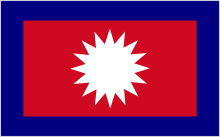Flag of Nepal
 | |
| Name | Nepali Flag, Triangle Flag, Chandra ra Surya, Jungi Nishan |
|---|---|
| Use | National flag |
| Proportion | see below |
| Adopted | 16 December 1962 |
| Design | A combination of two red pennons (pennants) with the large blue border around the unique shape of two overlapping right triangles: the smaller upper triangle bears the white stylised moon (the rising sun on the horizontal crescent moon) and the larger lower triangle displays the white twelve-pointed sun. |
The national flag of Nepal (Nepali: नेपालको झण्डा) is the world's only non-quadrilateral national flag. The flag is a simplified combination of two single pennons (the vexillological word for pennants), known as a double pennon. Its crimson red is the colour of the rhododendron, Nepal's national flower, while the blue border is the colour of peace. Until 1962, the flag's emblems, the sun and the crescent moon, had human faces, but were removed to modernize the flag.
The current flag was adopted on 16 December 1962, along with the formation of a new constitutional government.[1] It borrows from the original, traditional design,[2] used throughout the 19th and 20th Centuries, and is a combination of the two individual pennons used for more than 2,000 years.
Symbolism
After Prithvi Narayan Shah unified all small principalities of Nepal, the double-pennon flag was adopted. In modern times, the flag's symbolism has evolved to incorporate several meanings. The crimson red indicates the bravery of Nepali people and is the country's national colour and the blue border represents peace and harmony. The colours are often found in Nepalese decoration and works of art.[1] The triangular shape of the pennons originally represented the Himalayas, with their sizing denoting important families - Shahs for the upper, and the Ranas below. Another theory is that the two points represented peace and hard work, using the symbols of the moon and sun respectively. However, the modern and government sanctioned representation is of Hinduism and Buddhism, the main religions of the country.[3][4]
The inclusion of the celestial bodies indicates Nepal's permanence, and the hope that Nepal will enjoy the same longevity as the Sun and the Moon. Additionally, the stylized moon represents the calm demeanour and purity of spirit of the Nepali people, while the stylised sun represents their fierce resolve. Further, the moon also symbolizes the cool weather of the Himalayas, whereas the sun symbolizes the heat and the high temperature of the Nepali lowlands (Terai).[3]
Flag layout
A precise description of the Nepalese national flag in the Constitution of the Kingdom of Nepal, Article 5, Schedule 1, adopted 9 November 1990.[5]
Aspect ratio
According to the stated geometric construction law, the circumscribed rectangle has an irrational ratio of:
≈ 1:1.21901033… (![]()
and arises from the addition of the blue border after construction of the red field. The bounding rectangle of the red field alone has the rational aspect ratio 3:4 (=1:1.333…).[5]
Other flags
.svg.png)



Incorrect versions
.svg.png)
The shape of the flag of Nepal is difficult to reproduce, and is often used incorrectly. These typically have a white area to make the flag a 3:2 ratio; an example is the Nepalese Flag used at the 2016 Summer Olympics.[8]
During a 2018 visit of the Prime Minister of India to Province 2, a version of the flag with incorrect colouring was flown by officials, causing outrage on social media and with national personnel.[9][10]
See also
References
- 1 2 "Flag of Nepal". Encyclopedia Britannica. Retrieved 2018-07-24.
- ↑ Article I, Section 5 of the Constitution of Nepal (2018)
- 1 2 "The World Factbook — Central Intelligence Agency". www.cia.gov. Retrieved 2018-07-24.
- ↑ "What's with the funny shape of Nepal's flag?". Public Radio International. Retrieved 2018-07-24.
- 1 2 "Nepal - Constitution - Schedules: Schedule 1 (Relating to Article 5)". International Constitutional Law, University of Bern. 1990-11-09.
- ↑ "Calculation of the aspect ratio of the national flag of Nepal (Berechnung des Seitenverhältnisses der Nationalfahne von Nepal)". 2012-06-08. Retrieved 2016-08-11.
- ↑ Sloane, N.J.A. (ed.). "Sequence A230582 (Decimal expansion of the ratio of height to width of the bounding rectangle of the national flag of Nepal, as defined in Schedule 1 of Article 5 of its Constitution.)". The On-Line Encyclopedia of Integer Sequences. OEIS Foundation.
- ↑ "Closing Ceremony, 2016, Olympic Ceremonies - BBC Sport". BBC. Retrieved 21 December 2017.
- ↑ "Ministry seeks explanation on disfigured national flag". Retrieved 2018-07-24.
- ↑ "Province 2 sets up wrong flag of Nepal during Indian PM Modi's visit - News, sport and opinion from the Kathmandu Tribune's global edition". News, sport and opinion from the Kathmandu Tribune's global edition. 2018-05-12. Retrieved 2018-07-24.
External links
| Wikimedia Commons has media related to Flags of Nepal. |
- Nepal at Flags of the World
- Grime, James. "The Most Mathematical Flag". Numberphile. Brady Haran.
- Explore Nepal - Download Nepal Flag
- Amazing Facts about Flag of Nepal